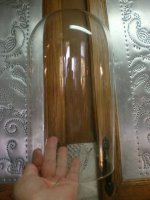Hi guys,
I was planning to do something somewhat unconventional;
I would like to create a kind of mini city using several (3 or 4) old vacuum tubes. For this I would like to keep part of the original innards and also remove and add some parts to make the insides look more like little homes. Then add some lights and maybe some little roads between the tubes.
This would mean grinding the bottom of the tube off with a diamond wheel and also grinding off some of the structure of the inside.
But I'm not sure if this is safe since I don't know what materials were commonly used back then. I won't be using any exotic tubes, more like a couple of el84's for example.
Do I need to be afraid of any coating materials or things like asbestos? I believe the spacer plates where made from mica and not asbestos, is this correct?
I was planning to do something somewhat unconventional;
I would like to create a kind of mini city using several (3 or 4) old vacuum tubes. For this I would like to keep part of the original innards and also remove and add some parts to make the insides look more like little homes. Then add some lights and maybe some little roads between the tubes.
This would mean grinding the bottom of the tube off with a diamond wheel and also grinding off some of the structure of the inside.
But I'm not sure if this is safe since I don't know what materials were commonly used back then. I won't be using any exotic tubes, more like a couple of el84's for example.
Do I need to be afraid of any coating materials or things like asbestos? I believe the spacer plates where made from mica and not asbestos, is this correct?
I don't think you will find asbestos. Some high power valves may include Beryllium Oxide, the dust of which is highly toxic. Normal receiving valves will not have this.
Most of the metal inside will be an alloy of nickel. Things to be wary of are the cathode coating and the getter. These are metal oxides and may be toxic or even slightly radioactive. However, provided that you wash your hands after handling and keep children and pets away all should be OK.
I suspect that if you touch the anode with a grinder then it will rapidly fall apart, as the metal is likely to be quite thin - which is why it needs mica to hold it in place.
Most of the metal inside will be an alloy of nickel. Things to be wary of are the cathode coating and the getter. These are metal oxides and may be toxic or even slightly radioactive. However, provided that you wash your hands after handling and keep children and pets away all should be OK.
I suspect that if you touch the anode with a grinder then it will rapidly fall apart, as the metal is likely to be quite thin - which is why it needs mica to hold it in place.
The easiest way to get the tube "innards" out of the tube is to wrap the tube in a towel, and strike it with a hammer just hard enough to break the glass. The anode can be cut with scissors. As DF96 said, it's quite thin material. Wash you hands and/or use nitrile gloves and you will be fine.
Some thoughts, in no particular order.
The old bottle cutting trick of wrapping cotton string, where the break is wanted, wetting with rubbing alcohol, and setting it alight may be of use. Cut glass edges are dangerous and need "fire polishing". Either a propane torch or a laboratory burner works.
Getters are made from metallic barium, cesium, or rubidium. All of the above are highly reactive and their oxides form strongly alkaline solutions with water.
Cathode melts are known to contain barium and strontium carbonates. The carbonates convert to oxides, when heated. So, the water/alkalinity issue is present here too.
Thoriated tungsten filaments, as found in 211s, 845s, and other transmitting types are mildly radioactive. Don't breathe or ingest any dust. The alpha particles emitted are not particularly dangerous to your skin.
The old bottle cutting trick of wrapping cotton string, where the break is wanted, wetting with rubbing alcohol, and setting it alight may be of use. Cut glass edges are dangerous and need "fire polishing". Either a propane torch or a laboratory burner works.
Getters are made from metallic barium, cesium, or rubidium. All of the above are highly reactive and their oxides form strongly alkaline solutions with water.
Cathode melts are known to contain barium and strontium carbonates. The carbonates convert to oxides, when heated. So, the water/alkalinity issue is present here too.
Thoriated tungsten filaments, as found in 211s, 845s, and other transmitting types are mildly radioactive. Don't breathe or ingest any dust. The alpha particles emitted are not particularly dangerous to your skin.
I don't know. What I do know is that barium, cesium, and rubidium have been used as getters. AFAIK, barium is commonplace. It really doesn't matter, as all 3 are highly reactive and their oxides dissolve in water to form high pH solutions. These bases are somewhat stronger than sodium hydroxide (lye) and concentrated lye solution will dissolve flesh.
Kept out of the eyes and skin breaks, dilute bases are reasonably safe. Eye protection is a very good idea, under many sets of circumstances.
Kept out of the eyes and skin breaks, dilute bases are reasonably safe. Eye protection is a very good idea, under many sets of circumstances.
The white of knackered getters is reactive metal oxide. Add water and the result is alkaline.
Sodium Bicarbonate (baking soda) also makes an alkaline solution with water. Why is it dangerous in this case? Also, Sodium Hydroxide has a PH of 14. You can't get any higher than that, right?
The value of pH depends on the "activity" of solvated protons, which is concentration related for strong acids and bases. A 1 molar solution of HCl exhibits a pH of approx. 0. Get NaOh concentration > 1 molar and the pH is above 14. At 25o C., the solubility of NaOH is 1000 g./l. The formula weight of NaOh is roughly 40 g./mole and solutions more concentrated than 1 molar are not difficult to prepare.
As for why a pH of 7 is "neutral", refer to the ion product constant of water.
As for why a pH of 7 is "neutral", refer to the ion product constant of water.
Asbestos itself, like berillium oxide, are not toxic. The same way tiny glass particles can stuck in lungs causing the same horrible problem. Asbestos was banned after workers breathing asbestos dust damaged their lungs.
There are numerous "flavors" of pneumoconiosis. Miners' "Black Lung" and textile workers' "Brown Lung" are examples.
Asbestos is a particularly bad actor, as it is a powerful carcinogen, in addition to its mechanical properties.
Asbestos is a particularly bad actor, as it is a powerful carcinogen, in addition to its mechanical properties.
Ok, thanks for all the information! I think I might just not do it then, seems like it would be a bit to much in terms of chemicals etc.
Asbestos is a particularly bad actor, as it is a powerful carcinogen, in addition to its mechanical properties.
The silicate tetrahedron (SiO4) is the basic chemical unit of all silicate minerals.
Are they all carcinogenic then?
What about using test tubes and cutting them to length?
EDIT: If you can't find non-tempered tubes, you can anneal them in a pottery kiln and then cut.
EDIT: If you can't find non-tempered tubes, you can anneal them in a pottery kiln and then cut.
Last edited:
Interesting. All the safe playthings from my childhood are now sources of mortal danger. I must count my blessings 🙂
You can get pre-made glass domes for mantle clocks or displays. Plastic ones too that won't break.
I've seen fake giant tubes made with these, an LED strip inside for the heater.
Clock, Doll or Display Glass Dome 3.5 x 6.5 With (Walnut Base) | eBay
I've seen fake giant tubes made with these, an LED strip inside for the heater.
Clock, Doll or Display Glass Dome 3.5 x 6.5 With (Walnut Base) | eBay
Attachments
Last edited:
Asbestos in a stable form is not toxic, simply because it does not get into your lung. However, keeping it stable can be difficult.Wavebourn said:Asbestos itself, like berillium oxide, are not toxic.
Beryllium oxide is toxic, but fortunately very insoluble so you need fine particles to get enough in solution to do harm - then it gets rather nasty. OK to handle intact devices, but don't break them!
There is a huge difference between a mild alkali like sodium bicarbonate and a strong alkali like sodium hydroxide. Does the pH scale end at 0 and 14? I suspect not, but few common substances exceed these values.kodabmx said:Sodium Bicarbonate (baking soda) also makes an alkaline solution with water. Why is it dangerous in this case? Also, Sodium Hydroxide has a PH of 14. You can't get any higher than that, right?
- Home
- Amplifiers
- Tubes / Valves
- Cutting open vacuum tubes - dangerous?

